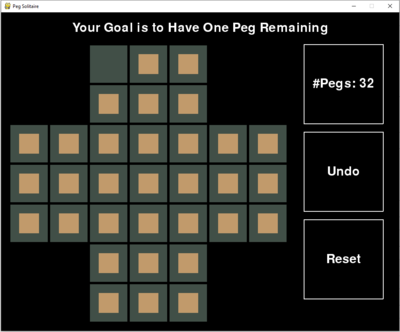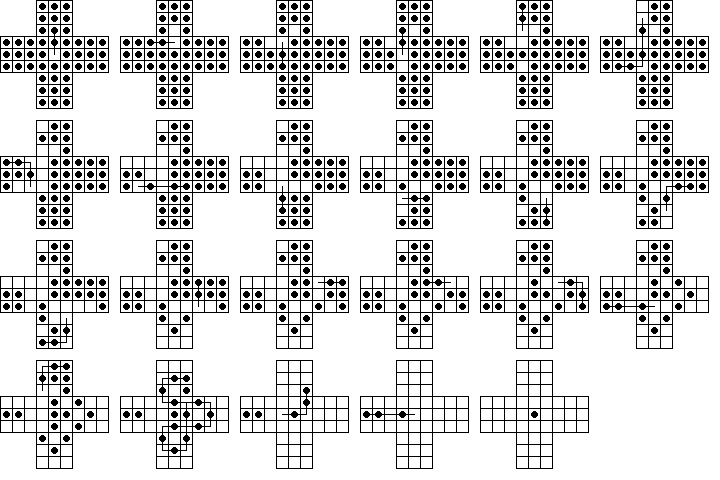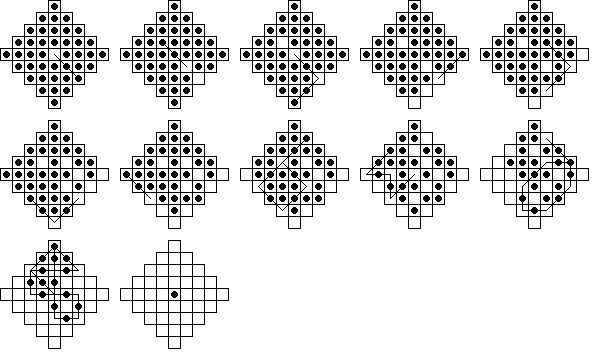

Other alternate games include starting with two empty holes and finishing with two pegs in those holes. This technique can be used with a line of 3, a block of 2♳ and a 6-peg L shape with a base of length 3 and upright of length 4. In the example below, the * is the catalyst.: * There are, however, several other configurations where a single initial hole can be reduced to a single peg.Ī tactic that can be used is to divide the board into packages of three and to purge (remove) them entirely using one extra peg, the catalyst, that jumps out and then jumps back again. Hence a final position with only one peg cannot be reached, since that would require that one of these numbers is one (the position of the peg, one is odd), while the other two numbers are zero, hence even. Hence after an even number of moves all these three numbers are even, and after an odd number of moves all these three numbers are odd. After every move the number of covered A positions increases or decreases by one, and the same for the number of covered B positions and the number of covered C positions. Initially with only the central position free, the number of covered A positions is 12, the number of covered B positions is 12, and also the number of covered C positions is 12. Divide the positions of the board into A, B and C positions as follows: A B C This is easily seen as follows, by an argument from Hans Zantema. There is no solution to the European board with the initial hole centrally located, if only orthogonal moves are permitted.


On the English board the equivalent alternative games are to start with a hole and end with a peg at the same position. This mirror image notation is used, amongst other reasons, since on the European board, one set of alternative games is to start with a hole at some position and to end with a single peg in its mirrored position. There are many different solutions to the standard problem, and one notation used to describe them assigns letters to the holes: English European On an English board, the first three moves might be: Thus valid moves in each of the four orthogonal directions are: * A blue ¤ is the hole the current peg moved from a red * is the final position of that peg, a red o is the hole of the peg that was jumped and removed. indicates a peg in a hole, * emboldened indicates the peg to be moved, and o indicates an empty hole.
#STAR PEG SOLITAIRE SOULTION CRACKER#
The objective is, making valid moves, to empty the entire board except for a solitary peg in the central hole.Ī man playing triangular peg solitaire at a Cracker Barrel restaurant.Ī valid move is to jump a peg orthogonally over an adjacent peg into a hole two positions away and then to remove the jumped peg. The standard game fills the entire board with pegs except for the central hole. This is the first known reference to the game in print. The August 1687 edition of the French literary magazine Mercure galant contains a description of the board, rules and sample problems. The first evidence of the game can be traced back to the court of Louis XIV, and the specific date of 1697, with an engraving made ten years later by Claude Auguste Berey of Anne de Rohan-Chabot, Princess of Soubise, with the puzzle by her side. It is also called Brainvita (mainly in India, where sets are sold commercially under this name). The game is known simply as Solitaire in the United Kingdom where the card games are called Patience. Some sets use marbles in a board with indentations. Peg solitaire (or Solo Noble) is a board game for one player involving movement of pegs on a board with holes. The Princess of Soubise playing solitaire, 1697


 0 kommentar(er)
0 kommentar(er)
